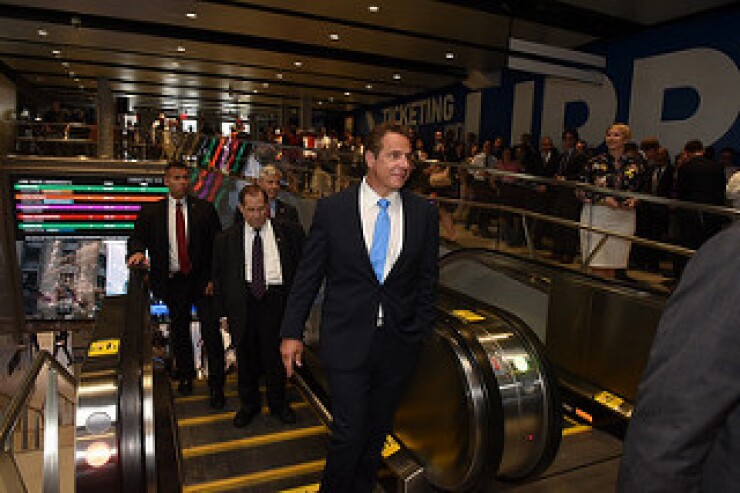A remark by Gov. Andrew Cuomo, well into a ceremony for the new Penn-Farley west concourse at New York’s Penn Station, could reinvigorate discussion about congestion pricing, a concept backers say could generate billions for mass transit among other benefits.
As a summer of hell looms for Long Island and New Jersey commuters because of emergency Penn Station track repairs by Amtrak, Cuomo on Monday mentioned a planned 50% reduction of overnight bridge tolls for trucks on the Long Island Expressway.
“It’s a form of congestion pricing,” Cuomo said of the move, one of several mitigation measures. “I’m very curious to see how that works.”

Cuomo in the past had been noncommittal, even standoffish, about the idea.
Supporters of congestion pricing – used notably in London -- say it will fund transportation infrastructure, ease congestion in Manhattan and make tolls more equitable throughout New York City’s five boroughs.
Its champion is “Gridlock Sam” Schwartz, a transportation engineer and New York City’s traffic commissioner in the early 1980s.
The plan would impose tolls on now-free East River bridges and traffic moving south across 60th Street in Manhattan, just north of the Ed Koch Queensboro Bridge, the northernmost of the now-free bridges that would be tolled.
Schwartz has said his Move NY Fair plan, which has yet to gain traction in Albany, could raise nearly $1.4 billion in annual new revenue that when bonded, could generate more than $12 billion.
Some discussion in transportation circles even included whether New York City itself could toll the East River bridges without state approval.
“I am not sure if they can actually do that but I think it would be better if the state, through the MTA, coordinated that,” said Howard Cure, director of municipal bond research for Evercore Wealth Management.
“The congestion pricing is a hard sell politically, particularly for state and city legislators from certain areas of Queens and Brooklyn but as mass transit becomes desperate for new funding, it may be the only alternative,” said Cure. “It would also improve quality of life issues in Manhattan.”
New York’s transit crisis -- with its extensive breakdowns and delays -- has prompted creative discussions about how best to combat aging infrastructure, turf wars among regional agencies, chronic underfunding and uncertainty about federal aid.
The Metropolitan Transportation Authority, which operates LIRR, last week announced a far-reaching mitigation plan for Long Island commuters.
The initiative, the cost of which the MTA is still assessing, will include ferry service and shuttle buses to and from Long Island and connections to New York City subway stations. That’s in addition to the truck-toll discount, intended to encourage nighttime truck use and minimize congestion on the Long Island Expressway.
Emergency repairs such as Amtrak’s track work affecting Long Island Rail Road and New Jersey Transit, and the MTA’s pending shutdown of the Canarsie tunnel, which carries the L subway line between Manhattan and Brooklyn, have prompted calls for alternative transportation such as ferries and bicycles.
New York City has begun expanding ferry service throughout some of the outer boroughs and some New Jersey advocates are pushing ferries as a counter to the Penn Station mess.
According to Cure, ferry demand will be strong if rides remain subsidized at the same fare as subways.
“I don’t know how much the city is willing to expend on this service and it isn’t always coordinated with other transit options,” he said.





